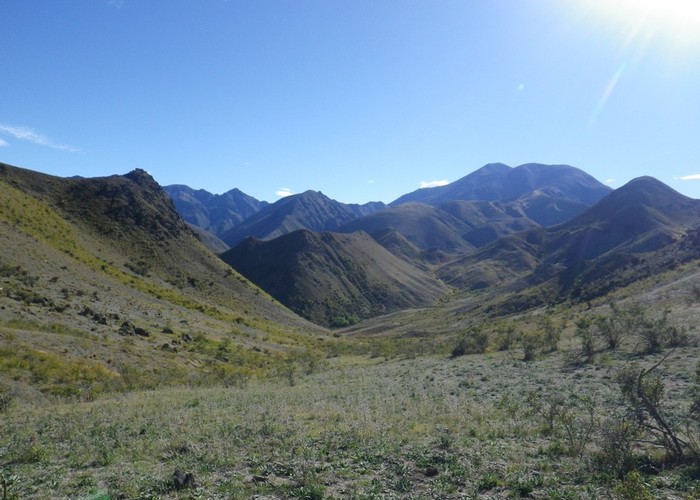Day 1. Kahutara river mouth to Wardens Hut
The intercity bus drops me off at Peketa – the small township at the south end of the Kaikoura Bay. Not a regular stop, the driver informs me, but he’s cheerful, and wishes me good tramping. A track on the inland side of the bridge leads to the riverbed, and cutting under the road I walk the 100m to the shore. The Pacific Ocean is dark and choppy, the water uninviting, reflecting the dismal colour of the sky. To the north the long flat sweep of the bay leads uninterrupted to the Kaikoura Peninsula some 7km away. To the south the road and railway squeeze improbably round a vertical coastline, navigating bluffs and spurs by sheer cuttings and tunnels. I’m relieved to see that the Kahutara River is no more than a trickle – the forecast for the last few days having been for rain.
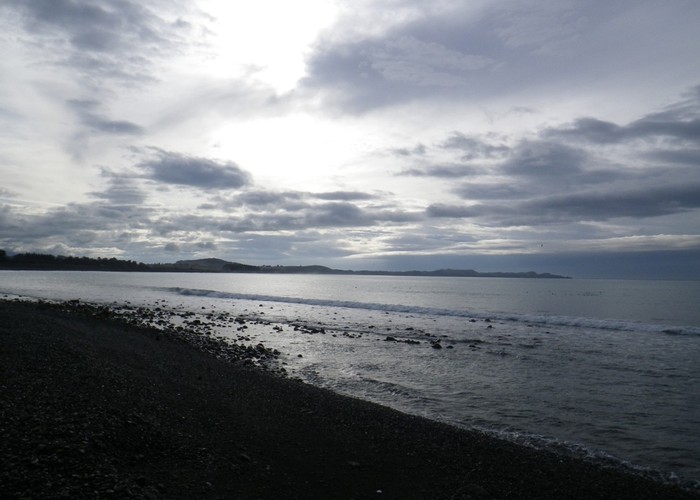
Might as well get on with it then.
A 4WD track leads back under the road and rail bridges, heading up the riverbed – carving a canyon through tall lupine and buddleia. The river gravel is soft, walking takes effort, like running on sand-dunes. I follow the track, which in turn follows the Kahutara as it winds inland. The Seaward Kaikoura range frames the horizon 20km inland, peaks barely peeking through rapidly enveloping cloud, low ranges lying between me and their base, forcing both river and myself to twist and wind our way inland. Pigs grunt and shuffle in the lupin. A startled brrrr of departing quail. The chirp of plover making their way upriver.
After a few kilometres the weeds in the riverbed recede sufficiently to offer views of the surrounding valleysides. Faces once cleared for farming, now returning to nature, of a sort. Slopes green with broom, patches of manuka pushing through – offer hope. The river winds through a broad-based gorge, crosses the gravelled Dairy Farm Road, narrows, confined to a single bed between weeping banks of old-man willow. I eat lunch under one, branches reach out over the riverbed, providing shade from a sapping sun.
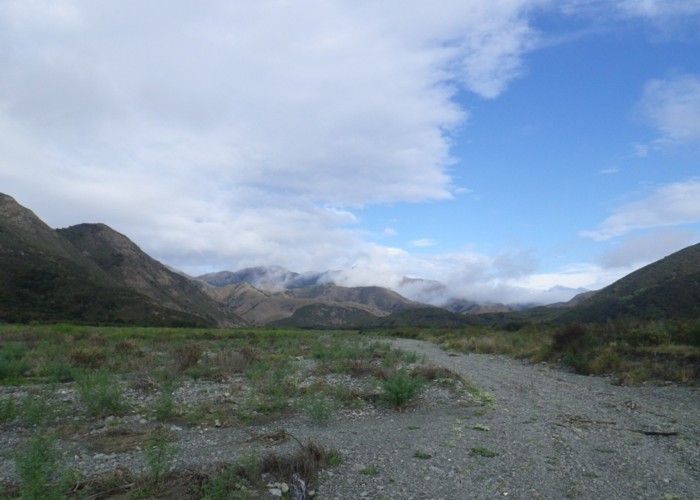
Trudge on upriver. A lone heron watches a pool. Pines appear dotting islands in the riverbed. Wattle too. Hard riverstones – feet hot and sore. The bridge forever round the next bend. I finally relent, get out the map, work out how much further. 500m to go to the Inland Route. 20 paces later I see it – a dozen concrete arches spanning dry riverstones.
We pass under the Inland Road, pick up a 4WD track on the northern riverbank. A lone DOC triangle on a pole confirms the route to Blind Saddle. Off the riverstones at last. A locked gate, stile. 4 cars, each with empty trailers & ramps in the paddock beyond. The river has been dry for the last several kilometres, cattle sign on the riverbed making it an uninviting drink below that. Water bottles are near dry, but the only source is a cattle trough, murky-green with algae. I push on.
The good farm track climbs through bush to terraces of farmland above. An easy gradient, gentle rise to the base of the range beyond. A series of zigzags take us off the flat, climbing between pine forest south and rough hill country to the north. Cloud has been lowering all day, lofty peaks no longer visible, and within minutes we enter it’s grey, damp world - climbing. Passing Bushy Saddle, the gradient increases, becomes steep, the track bulldozed into near vertical, crumbling faces. Three sips of water remain in my last bottle, and the sound of a truck approaching through the mist is a relief. I flag it down, ask if they have water to spare. ‘We have beer’, they reply. They rummage under the seats and finally find a bottle that resembles water. I slug some down, from the taste suspect beer would have been preferable. Try not to wonder how long it’s been there, what the bottle was used for previously.
Above the zigzags we break through cloud. A sea of white stretches east, interrupted only by the top-most 50m of the coastal range. North and west the high peaks of the Kaikouras rise to bare pyramid summits – less formidable now – we have climbed a good distance unseeing through the mist. Scrubby valleys separate narrow spurs of dry tussock and rock. The track cuts onto the northern face, climbs to Blind Saddle 1190m. Not a saddle at all, merely a shoulder on a sidespur 200m below the pass. Nearing the true pass, creeks appear - flowing with clean water, crisp tasting, welcome.
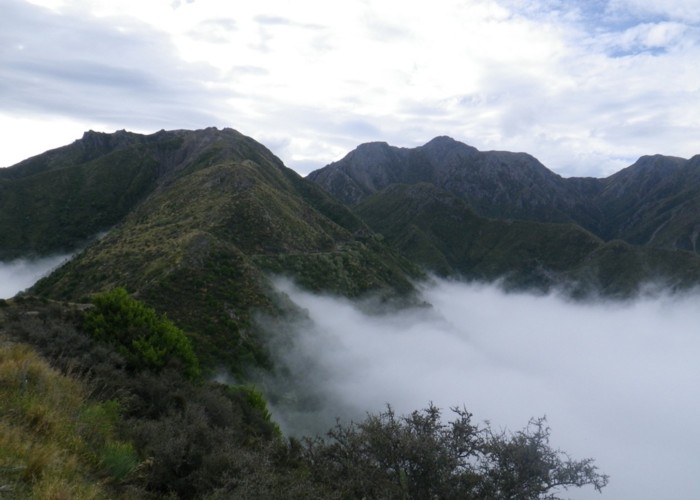
And so, refreshed, we cross the Seaward Kaikoura range. Beyond the unnamed pass the track sidles into a changed landscape. Steepsided valleys host more dirt than vegetation. Bluffs of deep veined rock - twisted, warped - melted candle drawn in stone. The road becomes even more precipitous as it drops, cut – a shelf – into sheer rock faces. Sidling, twisting through guts & spurs, until finally it finds a leading ridge, dropping with it towards the Herring below.
Finally, a hut. Candlesticks sits on the flat valley floor below the track. The side-creek off the Herring more swale than valley – dry, grassy with no bed for water to flow- the hut angled carelessly in its centre. No water now - no means to stay. What happens when it rains, I can only imagine. We push on: 2.5km to the main Herring River.
Where a collection of huts awaits: the historic Bluff Dump Hut, like Candlesticks, is stripped bare. A place of comfort for so long, now an empty shell for inspection by the curious. A modern DOC structure, stark and modern, sits nearby. But removing that day-1 pack, stretching out on the broad platform bunk on those firm DOC mattresses, Wardens Hut feels like paradise. It’s all I can do to force myself up for a wash and tea, before I collapse contentedly into soft down and oblivion.
Coast (SH1 Kahutara River bridge) -. Inland Route (Kahutara River bridge).
3hr15. Riverbed route with 4WD tracks. River ankle-deep or dry in normal flows. Easy going but mix of soft tiring surface and hard river stones. Forks in river require attention to map to choose the correct (main) river. Limited (or no) clean drinking water due to cattle in the riverbed until the Inland Route, above which the river is likely to be dry.
Inland Route (Kahutara River Bridge) -> Saddle
3hr. A 4wd track starts from the highway at the bridge, following the northern bank. After 2km a locked gate is reached. A 4WD track climbs first through farmland and later bush / scrub / tussock passing Blind Saddle to reach the unnamed saddle on the watershed. Only reliable water is in the last 500m to the summit.
Saddle -> Candlesticks Hut
1hr. A good 4WD track sidles through sheer bluffs before descending a spur towards the Herring River. Candlestick Hut sits 20m off the track up a dry riverbed 2.5km before the Herring is reached. The turnoff is signposted.
Candlesticks Hut -> Wardens Hut
20 mins. The good 4WD track continues to wind down from Candlesticks Hut until it reaches the Herring River. Crossing twice, a grassy flat containing both Wardens Hut and the historic Bluff Dump hut is reached.
Day 2 – Wardens Hut to Robinson Creek
An easy walk down the valley-floor 4WD track soon leaves Wardens Hut behind. The sky is a quilt of cloud – its diamond patchwork wearing thin in places to reveal blue beyond. A heron flaps lazily downriver – its wingbeats matching my pace.
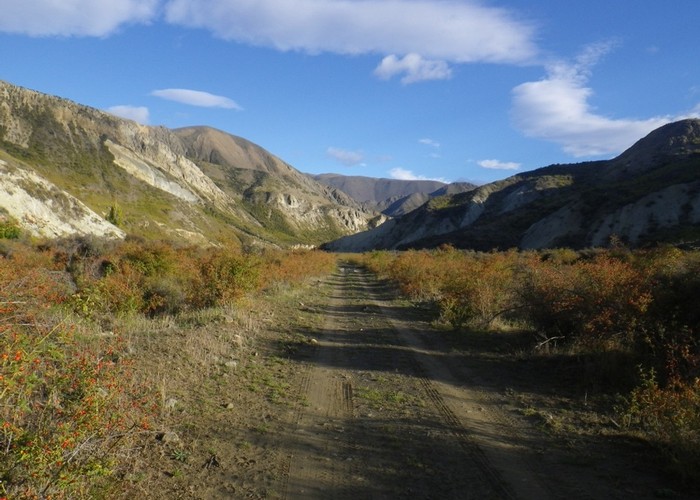
Black Spur Hut hides behind a sharp dividing spur of coal-black rock. Fancy that. A old slab hut, shaded by a grove of poplars. Iron bunks and fireplace remain – with a mattress it would still provide a cozy stay.
Wind whispers in poplars. We rejoin the Herring, continue downstream.
3km before the Clarence, the road splits. 4WD tracks head north and south. The good roadbed we’ve followed departs with then, and a rough riverbed 4WD route continues the last few kilometres to the Clarence River. Black rock changes abruptly to dazzling white. A twisting gorge, then the broad gravel Clarence flats.
Seymour Hut lies 500m downriver, on broad grassy paddocks behind a briar-covered bank. Hunters are resident, but absent, so I eat my smoko alone, and continue.
Heading up the Clarence, crossing the waist-deep flow three times. The current is swift - just beginning to tug, but comforting, flat gravel lies underfoot. The ice-axe provides reassurance against the flow – but with good runouts it’s a safe crossing. For a group with their mutual support, a doddle.
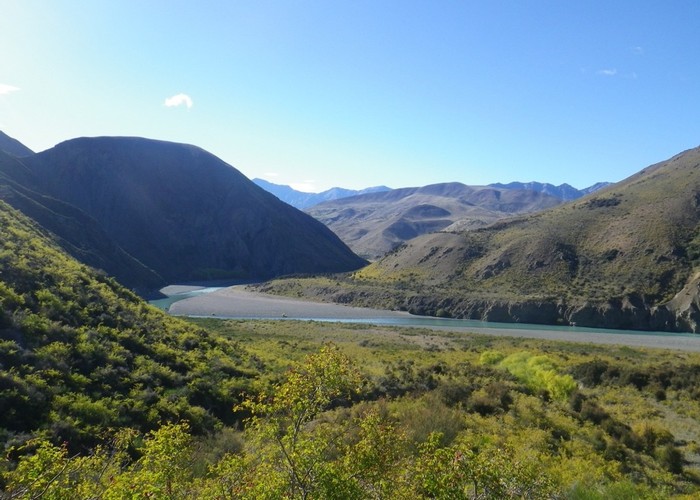
1km upriver a lone triangle beside a broom bush marks the start of the route to Lake McRae. A cut track climbs west up a sidecreek, reaching the saddle through a forest of rosebriar. At the pass, the track ends, but beyond the briar is sparser and we make a winding descent between the worst of the scrub, swinging left to the Elliot Stream. A forested valley floor of old-man willow awaits. We weave upriver between twisted trunks, fallen, still growing trees, cutting occasionally out onto sun-baked rosebriar flats.
Elliot Biv takes some finding - hidden atop a low terrace north of the river, itself obscured by tall willows. A hunter’s gear is in residence, unpacked but tidy. The hut stinks of death, like dead possum under the floorboards after 5 days of sun. The clearing abuzz with flies. Hot, unwelcoming. I return to the creek, eat lunch beside the clear flow in the shade of willows.
Above Elliot Biv we leave the willows behind. A good ground trail heads upriver, seeking out grassy clearings, forcing its way through rosebriar flats. The trail broadens, becomes an overgrown 4WD track, benched for a sidling climb to the saddle with Lake McRae. A gully, overgrown with briar, blocks our easy progress - forcing instead a brief, steep climb to the summit. Brown-white goats watch, unconcerned, from the valley floor below. Beyond the saddle, Lake McRae fills the valley floor. A wind lifts small white-caps, blows them, with short slapping splashes, onto the shore beneath me. At the far, southern, end willows shade a broad bay. A quick, refreshing swim follows in its clear, still water. An even quicker re-robing as sandflies descend for the kill.
Lake McRae Hut lies a full kilometer beyond the lake from which it takes its name, and a full 100m below it. The 4WD track descends in sweeping zigzags to a line of willows which mark the river below, the hut tucked – sheltered – at their start. Three hunters emerge as I approach, checking rifles, paying no attention to my presence. They depart: ‘Bit of a mess in there. We’ll tidy up when we get back’. A deer’s head rests against the porch, flies circling. More clouds orbit muslin bags of meat tied to trees, eaves nearby. Inside, gear covers every surface: beds, tables, floor. The hunters said that two parties are in residence, but how they’ll know which gear is who’s is hard to guess. I’d been mentally erecting my tent outside, coming in to read, cook tea, have a yarn. But to even do that would require tidying up gear, finding a surface on which to sit and to cook. And mixing up the strewn mess further will probably make me no friends. I could just lie up in my tent outside, await their return on dusk. But out there, in the company of flies …. well I might as well be further downriver and in peace.
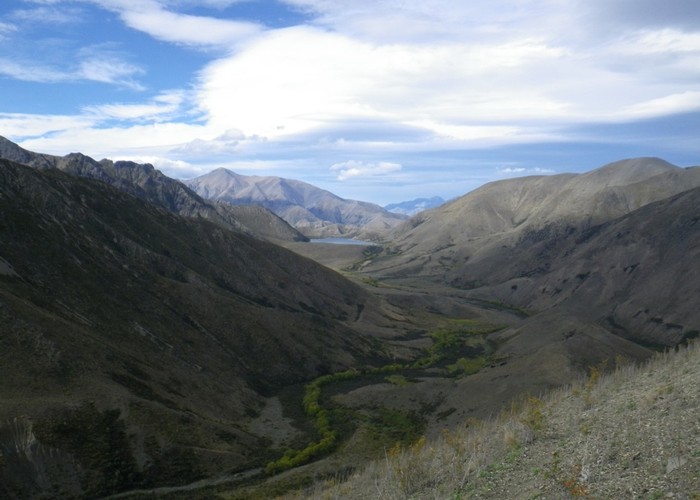
So I chew down a muesli bar, reshoulder my pack, and head on down the valley. The 4WD track winds south, cutting along sparse grass-and-briar river terraces on the western valleyside. Two kilometres downriver a broad valley joins from the west, a flat-floored incline rising towards a cirque of black scree-draped peaks. The East-West route heads up the valley floor, picking between willows and briar until it finds a ‘good spur’ on the southern face. Climbs steeply through first low briar, later bugloss and hieracium, to reach the southern ridgeline. A stepped series of ascents follow up the ridgeline, frequent stops to wipe sweat from my eyes. With each ascent the vegetation gets sparser, reduced to just a handful of weeds in each meter of rocky brown soil. And with each ascent the range of black peaks tower a little less. A cold wind picks up, chill sweat stinging skin. A final steep climb leads onto a face of fine black rock, sidling first north then south of low black peaks we reach the saddle, and cross our second range.
Beyond: a new landscape. Valley floors flush with green growth. Tussocks punctuate the faces, where previously briar and bugloss reigned unopposed. I drop steeply down rolling tussock into the valley below, tired and eager to rest, descent watched by scores of black goats. The chill wind whips up the valley floor, and I push on a few more kilometres, finding shelter on flat grass terraces in the shade of the first patch of willows. Cattle too have appreciated their protection, and I find a new use for an ice-axe, clearing a spot for my tent. Sandflies appear and attack, but after a wash in the chill water of the creek I’m cold enough to cover up and cook tea. Retire, relieved to finally lie in the comfort of my tent.
I lie thinking: critical. I’m rushing the trip, I know it. My failing as always, the urge to push on. Tomorrow, I know, I won’t stop at Molesworth Camp as planned. I’ll push the day that bit more to reach the comfort of Saxton Hut. A roof over my head, table to sit at and read, cook, relax. A mattress and a bed, in place of another night under canvas. I should learn to stop, relax, accept whatever I find when I reach my planned destination. I fear the story of this trip will become another story of pushing against daylight and fatigue. This dreamed of tale of a transect through a half-dozen new ranges, ecosystems, environments reduced to that of just another slog.
Warden Hut -> Seymour Hut
Good 4WD track down the valley floor. Frequent crossings – ankle deep. Stick with the riverbed where the track climbs towards Quail Flat. Seymour Hut is 500m downriver on the eastern bank.
Seymour Hut -> Elliot Biv
Head upriver from Seymour Hut for 1.5km, ideally making three crossings of thr Clarence. The river was waist deep with steady, rapid flows but a good stable gravel bed when I visited in ‘normal’ conditions (recent light rain, no major storms). The first 2 crossing can be avoided by climbing over the low knob north of the Herring. The track to Elliot starts on the western side of the 2nd side-creek shown on maps upriver (and opposite) the Herring. A cut track climbs through briar to the saddle and ends. Cattle / goat tracks lead north down the far side in the valley before swinging sharply west to join the Elliot Stream. Follow the Elliot valley upriver in willows / briar flats. Elliot Biv is 1.5km upriver just above the next major forks. On the true left of the main river (above the forks) push through the willows and ascend onto a low terrace beyond. An overgrown bulldozed track may be visible climbing through willows from the creek. The hut is in the location shown by topomaps, atop this terrace.
Elliot Biv -> Lake McRae Hut
Above Elliot Biv, willows end and a good ground trail heads up the main Elliot valley. Take care to swing left at each of the three major forks until you pick up an old 4WD track climbing to the low saddle due east of Lake McRae. Drop to the lakeshore and follow the northern bank to the north-western end of the lake. Push though a narrow band of rosebriar on cattle tracks and pick up the 4WD track as it emerges from the scrub. Follow it as it sweeps down to the valley floor below, where Lake McRae Hut lies 1km beyond the lake, tucked against the riverside willows.
Day 3 – Robinson Creek -> Saxton Hut via Molesworth Cob Cottage
The remainder of the walk down Robinson Creek is uneventful. An old bulldozed track appears and disappears – we follow it or the riverbed to the forks with the Awatere. Broad flats of rich green grass are almost overrun with willows, but a good farm track follows the northern bank downriver and makes its way to the Molesworth Road. Hundreds of field mushrooms dot the flats, and I lift a prime specimen for breakfast.
A sheltered DOC campsite surrounds the original Molesworth Homestead site – the original two-room cob building still present in its centre. Stooping first under the eaves, then through the low doorway, I again wonder if people really were so much shorter in the past. A ranger is in residence at the campground – he gets his own tidy modern DOC hut, not for public use. He radios up for a forecast for me – three days of occasional showers: more of the same. Great.
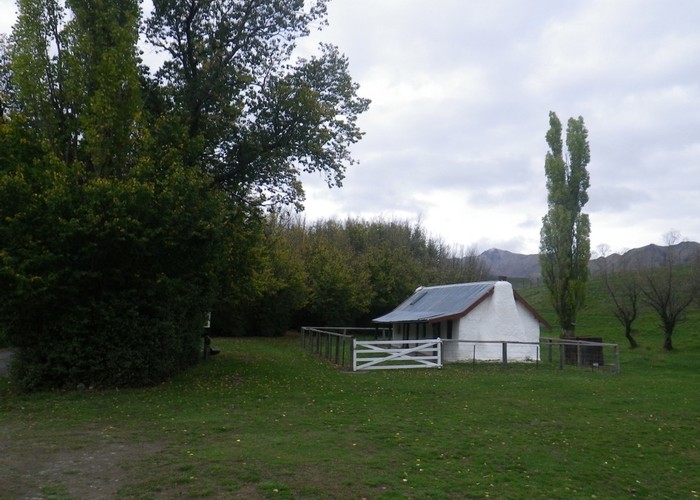
I fry up my huge mushroom at a picnic table – I have to cook it a bit at a time as it’s too bit to fit in the pan. Then it gets boiled down into a rich soup. Some grey nomads observe the process and call out ‘bacon & eggs?’ In my dreams, perhaps, but the soup is delicious all the same.
Avoiding the hard gravel of the Molesworth Road, the east-west route swings north on a softer farm track over the Saxton Pass – confusingly, several kilometres from the Saxton itself. An easy 5km climb beside a ribbon of willows leads to the saddle, followed a sweeping descent down short-cropped grass faces to the Acheron. Two kilometres later we’re back on the Molesworth Road, now west of Wards Pass, with the endless broad expanse of the Acheron flats stretching west into the distance – punctuated at 400m intervals by tall electricity pylons. 2.5km of straight, unchanging gravel road lies between us and the turnoff to Saxton Hut. Just 6 pylons to go! A V of ducks pass overhead, but the day is silent except for the static-hiss over overhead HV lines.
Hot-footed I’m resting at the Saxton roadend, reclined in the sun against the DOC signpost. Net-curtains of drizzle drape the upper valley, drawn and opened as each brief shower passes. A flash of light on Wards Pass vanishes, becomes a car – inching down the zigzags in a slow-motion helter-skelter, marble madness. Becomes a cloud of dust, accelerating across the flats towards us. I wait till it reaches the last pylon, lever myself up off the ground, and open the gate for them. A conversation follows, words inconsequential – already forgotten – but the cheerful warm aftertaste of which lingers still.
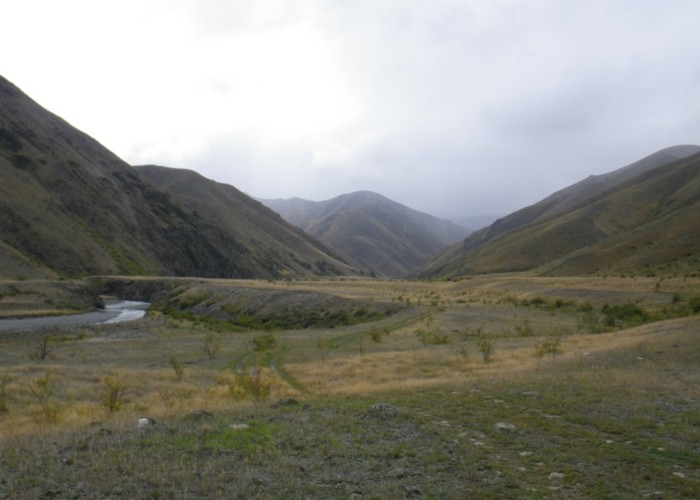
An easy six kilometre tramp up a little used farm track leads to Saxton Hut, criss-crossing the river at shin-deep fords. A little more water seeping into otherwise dry boots at each, until after the last I’m forced to admit that socks, boots, feet are finally wet. Saxton Hut perches on a small terrace above the forks – a pleasant six-bunker in the Whirinaki Style: bunks down one side, fire on the other. A spacious porch covers a water tank, gated to keep out curious neighbourly cattle-beasts. And I have the place to myself – a welcome sight.
Lake McRae Hut -> Molesworth Cob Cottage
Follow the overgrown farm track 2km downriver from Lake McRae Hut to the first major confluence from the west. Leave the track and head up the river through willows / briar scrub for 1.5km until you are level with the saddle between pt914 and pt1193. Climb the spur west of the saddle leading to pot 1193. Going is briefly scrubby but soon opens to a steep face of dirt and sparse rosebriar. Follow the ridgeline west climbing in a series of steps, over the summit east of Robinson Saddle, then sidling the southern face of the next peak directly west to the saddle on a well worn track across fine scree. Descend the tussock slopes into the valleyhead and follow the Robinson downstream on good open flats, cattle tracks and gravel riverbed. An old bulldozed track appear and disappears and can be followed where still present. At the confluence with the Awatere, cross the fenceline and Awatere River and pick up the good farm track heading down the true left. This can be followed all the way to the Molesworth Road, crossing the river twice more. Crossings are ankle deep in normal flows. Cob Cottage and the homestead campsite are 1km east along the gravel Molesworth Road.
Molesworth Cob Cottage to Saxton roadend
Head north from the Molesworth campground along the road (towards the east coast) for 1km, and take the signposted turnoff up Molesworth Stream. A good farm track follows the stream, climbing gently to the Saxton Pass, before descending into the Acheron. The track rejoins the Molesworth Road 2km down the Acheron. The Saxton Roadend is 2.5km further west along the gravelled Molesworth Road.
Saxton Roadend to Saxton Hut
A rough farn track head up the flats on the east bank of the Saxton, crossing three times in the next 2.5km. Crossings are shin deep in normal flows, but can clearly flood after rain. Saxton Hut is on a small terrace above the western bank, upstream of the first major confluence on the true right.
Day 4: Saxton Hut to Sedgemere Sleepout
Mist hangs low above the unnamed valley, moisture ripening the subalpine colours all around. For the first time we’re rewarded with a truly native palette. No more bichromatic landscapes of dirt and briar. Red and gold tints tussocks. Green, reds - hebes and speargrass cling on narrow ledges on the bluffed valleysides. Coprosma sparking, bark a wash of fiery orange. Stands of blue-green ribbonwood against black faces of matagouri. For the first time I feel myself relax, feel at ease. No longer making an effort to appreciate the landscape. No longer trying to see past the exotic, imported vegetation, to appreciate that even such a man-modified landscape can hold beauty. At last I tramp through New Zealand.
And truly I am tramping. A lovely valleyfloor route ascends to an easy saddle. Cattle tracks lead the way. Mist lightens as I climb, white rainbows spanning the valley ahead. Then, at the saddle, an abrupt change. Behind: a green gentle valley lush with vegetation. Ahead: a black scar gouged from the mountain. A deep, tight, dark V descending to the flats of the Severn far below, where sunlight shines on tussock, glistens off water. A fun, scree-running descent – but pity those who try to ascend it.
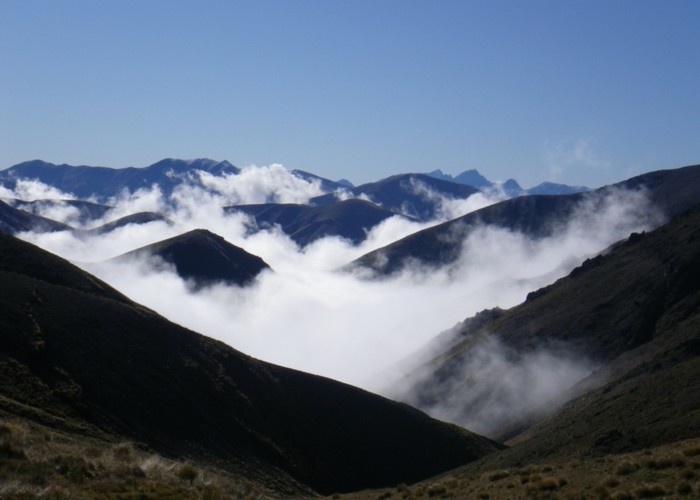
Severn Hut is new. Sitting tightly fenced on tussock terraces, looking up the broad valley to ranges at its head. Newly built to the original NZFS 6-bunk design – simple, practical, warm and homely.
The walk down the valley from Severn Hut is easy – terraces of short grass lead down the true left. A large creek, carved deep from black rock, descends from peak opposite. Downstream, a second attempts to follow it, finds its way blocked by a low ridge of impassable rock, swings to flow parallel to the Severn, unable to pass. Finally, the side-stream finds a weakness, cuts a narrow, twisting gorge through the ridge to join the main river: Dog Creek.
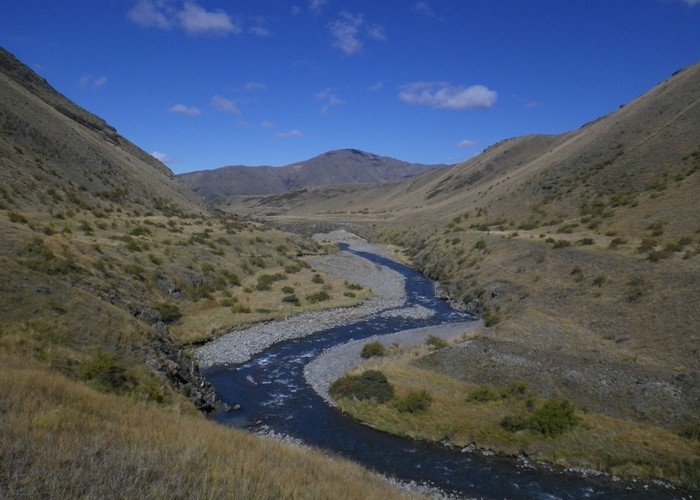
Beyond Dog, we climb west onto a low ridge - the continuation of that ridge that for so-long defied Dog Creek - now separating Waimea Stream from the main valley. A broad, flat valley, the Waimea rises gently to a low saddle 3km west. Tussock and sedge cover the marshy northern faces, the southern side short cattle-cropped grass. Sick of hunting cattle up and down valleys, I pick my way between mashed, navigating blind through head-high tussock. Finally I reach the pass, the tumble-zone in it lea crowned by row of dead wind-blown pines.
From a small lake below, a vast basin stretches into the distance – kilometres of undulating disturbed landscape, finally rising to peaks some 10km west. Tarns dot the landscape, filling each hollow. Mountains on all sides. Magic.
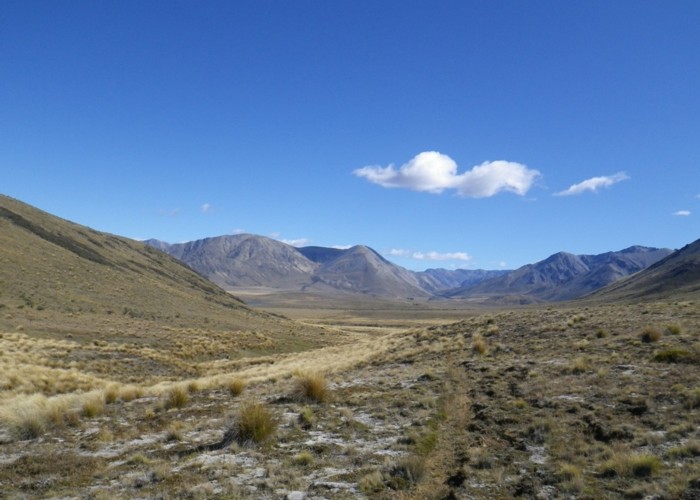
Cattle-tracks lead down to the lake, a 4WD track following its southern shore and running west to the gravel highway at Sedgemere. Even on the good trail, the basin takes hours to cross: trees, fenceposts, tarns appear, pass, recede, but the far mountains appear unchanging. South down the valley a single line of mature pines crosses the valley from east to west– the shelterbelt of some long-failed attempt at agriculture. Downwind a green rash peppers the valley for 10’s of kilometres. In places continuous, in others a mere decorative green sprinkle: 10,000 hectares of ‘busy progeny’ of those 100-odd original trees.
We finally reach the far side of the basin. A dark mark of the valley floor resolves itself into a small circle of pines. Sedgemere Chalet sheltered in its centre. No chalet for us though, 20 yards away a small, simple hut boasts the green DOC sign: Segdemere Sleepout. But with its six bunks and wood stove, in the shelter of those ‘busy pines’, it makes a welcome home after a long day in this vast landscape.
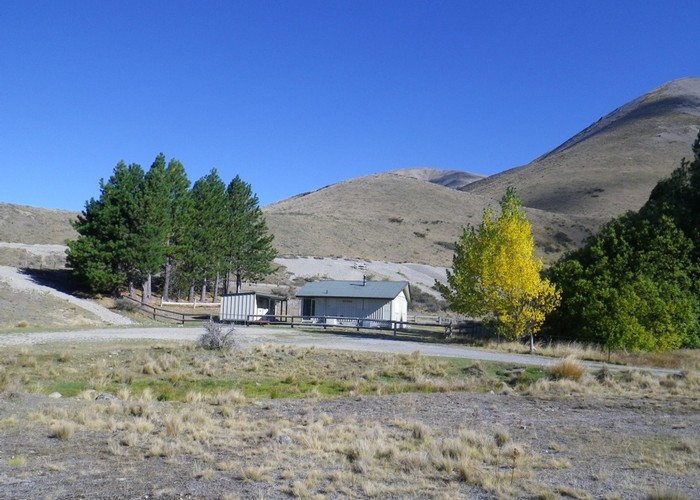
Sedgemere also marks the end of the Molesworth East-West route. We’ve traversed over 100km of high country farmland – seen land both actively farmed and retired. We’ve witnessed the changes that man has heaped upon the landscape – entire days of country dominated by introduced plants and animals. Tomorrow we finally leave that all behind and move on into the mountains of the Nelson Lakes National Park. I rest impatient – filled with anticipation of days in untouched valleys of tussock and beech, of challenging passes – rock and scree to the skyline. But also wary: uneasy at the thought of exchanging my days of solitude in a vast landscape, for huts and valleys packed with the scores of people who traverse the park every day. I try to guess what effect that change will have on the mood of the trip. Tomorrow, we find out.
Saxton Hut -> Severn Hut
An unmarked route follows the unnamed valley west from Saxton Hut. Good cattle tracks lead up the gentle valley to the pass. A steep scree ‘V’ descends beyond to the Severn. This can either be ‘run’ on it’s northern side, or you can climb the creek to the north of the saddle and follow a firm tussock ridge down to the Severn valley floor. Severn Hut is at the confluence, on the eastern bank.
Severn Hut -> Sedgemere Sleepout
Follow the Severn River downstream. There is no track but going is good on terraces on the eastern side, with a brief climb over low bluffs. Look for the 2nd major stream entering from the west – Dog Stream. Cross to the western valleyside, and climb the low ridge downstream of the Dog confluence and drop west into the Waimea. Travel is easiest low on the southern face of the Waimea where short cattle-cropped grass and cattle trails provide travel west to the saddle. Follow good cattle trails down to Bowscale Tarn, following the eastern then southern banks of the lake until you pick up a good 4WD track heading west. Follow the track 4km to the Sedgemere information kiosk where the public roadend and carepark are also located. Sedgemere Chalet (private) and Sedgemere Sleepout (DOC) are 1km west along the track from the kiosk / public roadend just before the junction with the Rainbow Road.
Day 5 – Sedgemere Sleepout to Paske Hut
Few images shout ‘The March of Progress’ so much as a line of pylons, glistening red in the dawn sunlight, as they stride across an otherwise wild landscape. Except, this being NZ, the red comes not from the dawn sunlight, but from streaks of rust.
The vast Sedgemere basin narrows to a tight valley - the Wairau, road and pylons hemmed in by steep faces of tussock, grey scree dribbling from peaks above. Six kilometres west of Sedgementre the road and pylons depart for destinations south, leaving us alone to enjoy the wild majesty. A rough 4WD track continues west on terraces south of the river, leads to an unexpected delight: Island Creek Hut. A tidy two room six-bunk hut, where two senior cyclist enjoy their breakfast and the landscape - likewise in peace.
I leave them to both, continue up cattle tracks along the south bank of the Wairau. I peer up side valleys 2,3 and 4 – seeking out a view of a viable saddle into the Paske to the north. But all terminate in walls of sheer rock. So instead, I follow the Wairau to its source below Mt Dora. Swinging north, the broad flats of tall tussock end at a rough wall of moraine, clad in greens and browns of hebes and subalpine scrub. The small creek – all that remains of the mighty Wairau River – has cut a channel through the post-glacial jumble, and I follow the grassed riverbank, climbing with decreasing pace into the head basin above. A near-vertical-looking curtain of scree hangs between the valleyhead peaks, piercing the crown-rocks to reach the skyline in just one narrow U bite. Desperately hoping that this narrow U connects with something useful on the other side of the pass, I climb. At first the scree face is stable – angular blocks of rock, bedded and firm – a sweat-inducing climb beneath blue skies and sun, but enjoyable amid this majestic landscape. One hundred meters later, the enjoyment is fast fading. Fine scree takes over, and despite the anchor of an ice-axe, each pace forward is rewarded with a shower of scree, a frustrating slide back. I rest, have a ‘blow’. Identify a rock 20m up. Gather energy. Scramble on. Reaching the rock, I rest, choose another, climb again. As the morning passes, the rocks get closer and closer. Rocks get replaced by paces: 20, 15, 10. Then breaths: 30 more and you can rest. Finally we reach the base of the crown rocks – drag myself up the last 20m of loose scree by hauling on the rockface itself.
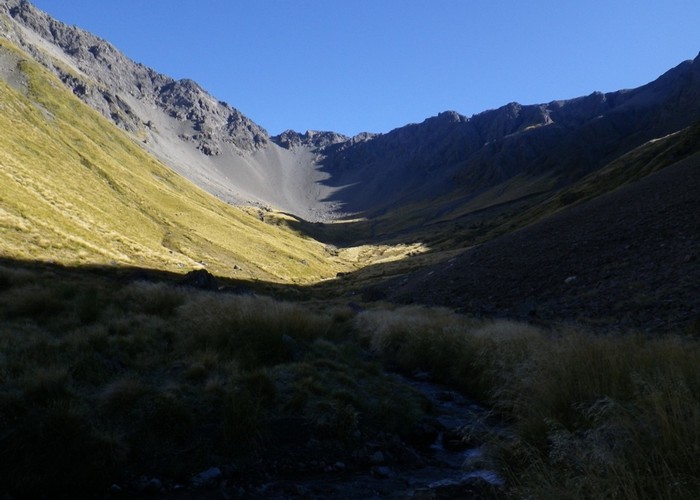
Cresting the pass, I’m rewarded by the view of which I had dreamed. A long chute of loose scree descends from the U-bite to the valley floor beyond. Prayers answered I rest, take in the landscape. A towering cirque dominates the head of the Paske: alternating layers of grey bluffs and scree terraces, like some massive, inside-out, layer-cake. Broad tussock flats below are fringed with beech forest – climbing the lower faces until first tussock, then bluffs and scree take over. The first native trees I’ve seen in 5 days of tramping.
The scree-run to the side-valley floor does not take long, nor does the walk down tussock faces into the beech fringed main valley. Paske Hut is tidy: a six-bunk NZFS hut. Reclad, porch added, but otherwise unaltered since the 60’s. And, what a spot it has: views up past the beech fringed valley flats to that amazing cirque at the valley head. This is what we’re out here for.
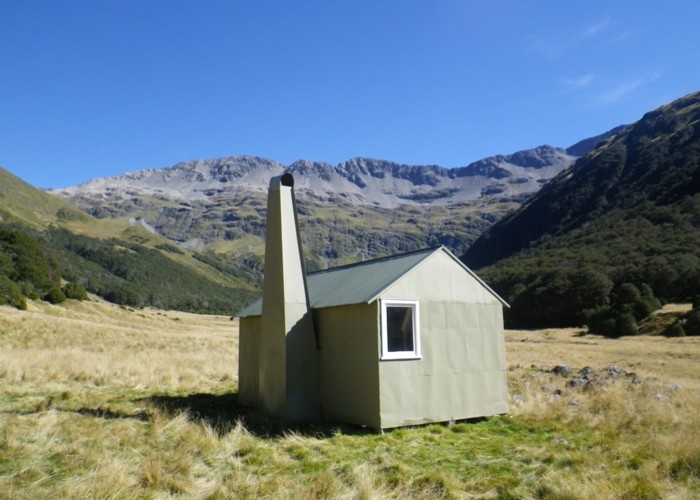
Sedgemere Sleepout -> Island Gully Hut
A good gravel road head up the Wairau from Sedgemere. After 6km the road swings south. A rough 4WD track turns off the road, continuing up terraces on the south side of the Wairau, signposted Island Gully Hut. The hut is 300m beyond the turnoff.
Island Gully Hut -> Paske Hut
Head up flats on the southern side of the Wairau from flats below Island Gully Hut, following good cattle tracks. The valley swings north, just after you cross a fenceline. Follow the creek north up the main valley through a landscape of moraine and scree into the scree head basin. Climb to the obvious U notch at the western side of the saddle at the valley head. Scree is firm lower down but very mobile higher up – slow going.
From the saddle drop good runnable scree on the far side into a side-valley off the Paske. Follow the northern bank downriver (NE) until you get to the start of beech forest. Drop to the main valley floor through beech. Paske Hut is 500m downriver on the southern bank.
Day 6 – Paske to Misery
We leave the hut and head down the Paske in the last colours of the morning light. Dew sparkles on knee high tussock, gaiters dark with moisture. The tussock flats look as if a herd of cattle has passed through – literally – so there’s a good ground trail to follow. Crossing the creek, a lone orange-painted tin-lid marks the start of a brief cut track through the beech, soon dropping back to tussock flats. Surrounding peaks – sheer and bluffed – become low, gentle, softer as we descend. A benched track has been cut into the western face, climbing from the gorging river to extensive terraces above. We encounter the herd of cattle. I cut a huge circuit around the edge of the flats, sticking to the scrub to avoid hunting yet another herd of cattle kilometres down yet another valley. To no avail: soon we form a long straggling line – cattle plodding ahead of us down the valley, latecomers following behind, rushing past us to catch up with their mates.
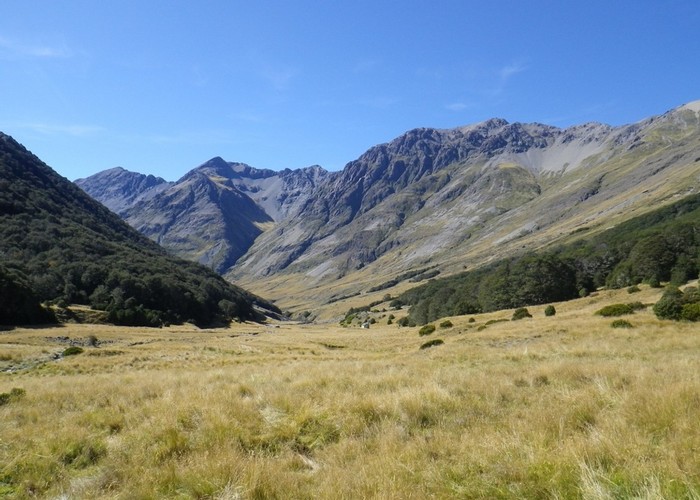
Wisps of mist creep round the corner from the Rainbow, solidifying into thick fog by the time we reach the confluence. Cutting north through a narrow tongue of beech onto the broad Rainbow flats, I leave the cattle standing confused downvalley – a vocal line of dark silhouettes against a halo of sunlit mist.
The ascent of the Rainbow starts with easy flats, passing the tight beech-clad V of the Begley to our north. After a few kilometres the valleysides close in, bringing patches of beech to the valleyfloor. Weaving our way, sometimes in the riverbed, sometimes bush, sometimes scrambling, rockhopping across the base of boulder-scree fans - we start to climb. The gradient increases as the valley swings north, and I struggle to change gear for the climb. Long days finally take their toll. Emerging at last from the beech forest into a basin of tussock and scree, the reality of the Rainbow Pass is revealed. Steep scree ascends for hundreds of meters to a 50m high band of crumbling crown rocks spanning the saddle. No viable routes through the broken rock band present themselves. I almost turn around, trudge back down the Rainbow despondent, but having come so far …
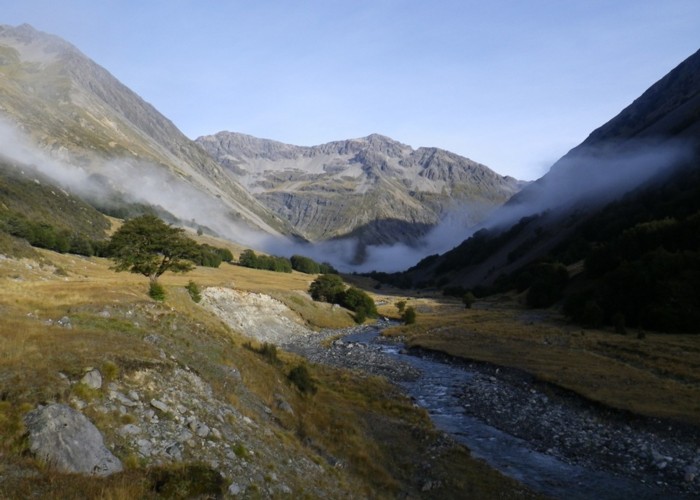
A look, at least: I climb into the scree basin at the valley head. Perspective tames the faces somewhat, and two routes emerge from the previously vertical wall. The most obvious climbs directly to the saddle at the far west of the scree face – bluffs lower down necessitating a long sidle from the eastern valleyside to access the base of the gut. The upper section through the rock-band is very steep, either fine scree or crumbling rock sprinkled with gravel – impossible to tell from here. It doesn’t look like fun. The second route climbs good rock-scree to the base of bluffs on the western valleyside, sidles below bluffs, climbing with them into a basin which leads to the western ridgeline.
I choose the latter – starting simple: an easy scramble up grassed rock-scree faces to the base of bluffs to the west. Following the base of the line of bluffs north, we climb gently with them. A gouged-out gut, invisible from the valley floor, presents the first challenge: I scout around before finding points to drop in and climb back out of the ravine. On the far side, I find myself 20m below the base of my bluffs; a nasty scramble up rock ensues, stable, but exposed to that deep ravine below. Back below my bluffs, the good sidling climb resumes. Steep scree faces follow the bluffs upwards in a series of steps - scree stable, but a constant gradient taking its toll. We finally emerge into a large flat-bottomed basin littered with boulder-moraine. Short scree slopes on three sides lead to the sharp rocky ridgeline 20m above – jagged rock promising precipitous descents beyond. The Rainbow Pass is just north-east and below us, and a 20m scramble across steep, narrow benches of stable rock is required to reach the pass. I hesitate. Below the sidle: 20m of bluffs then 700m of fine powder-scree dropping all the way to the valley floor: that steep gut leading to the pass that we’d eyed up from the base. Nothing but endless bounces to slow a fall. We make it ok, however, and 60 nervous seconds later are standing on Rainbow Pass at its westernmost extent.
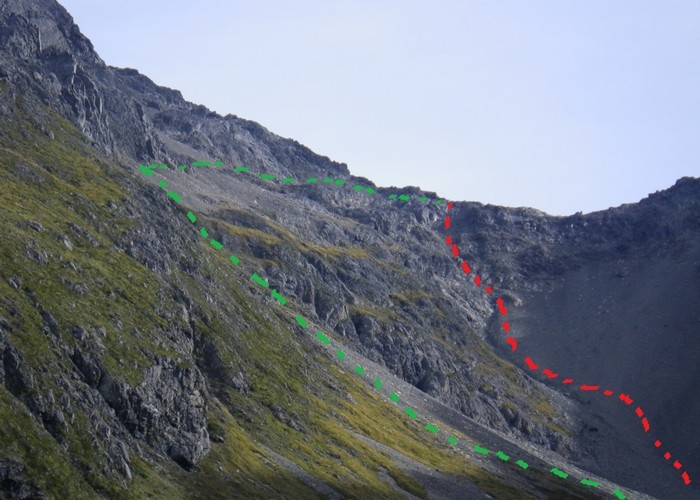
South of Rainbow Pass, the broad rocky table that forms the Travers Saddle is stunning. Steel blue tarns glint under midday sunlight. Surfaces rippled and patterned by a squally, gusting breeze. Dropping to the largest, I rest against a warm boulder, eating my lunch and enjoying the tranquillity – for just 200m beyond lies the busy Travers-Sabine circuit.
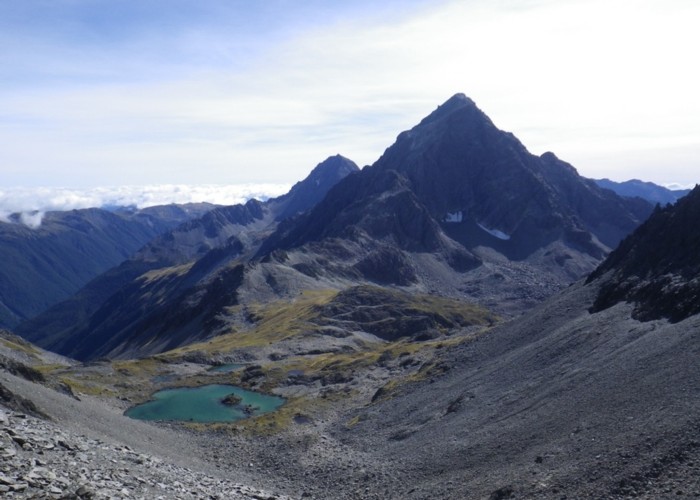
I fight disappointment: Rainbow Pass was the keystone to this entire route - the vital piece that joined the East-West Route to the east with the network of tracks crossing the Nelson Lakes to Kahurangi to the west. I enjoyed the challenge of that exposed rock and scree scramble over Rainbow, but I know I could never recommend it to anyone unless I knew them well, understood their abilities, had full confidence in their judgement. A challenging route for the adventurous: it could never be a part of a popular coast-to-coast tramp. I’ll need to return to this area, scout out alternative passes: the gentler climb up Begley to the east, with its steep bushclad descent into the Travers; or the uninspiring-looking scree-plods over Paske and Clarence saddles into the Sabine to the west. A definitive coast-to-coast route will have to wait – ‘further research is required …’
===
The sky changes as I rest: vivid blue fading to the same steel-grey of the tarns. Streamers of high cloud appear. A change is coming …
I head north across the saddle, join the well worn trail. The descent into the Sabine is easy after so many untracked days: disengage brain and follow the orange markers. Which gives all the more opportunity to take in the scenery. The East Sabine below is a flat glacial U of a valley, thick beech forest carpeting the flats, climbing impossibly up near vertical valleysides. A dark line of shadow runs down the valley floor, an echo in the forest canopy of the narrow, deep canyon the Sabine River has cut for itself.
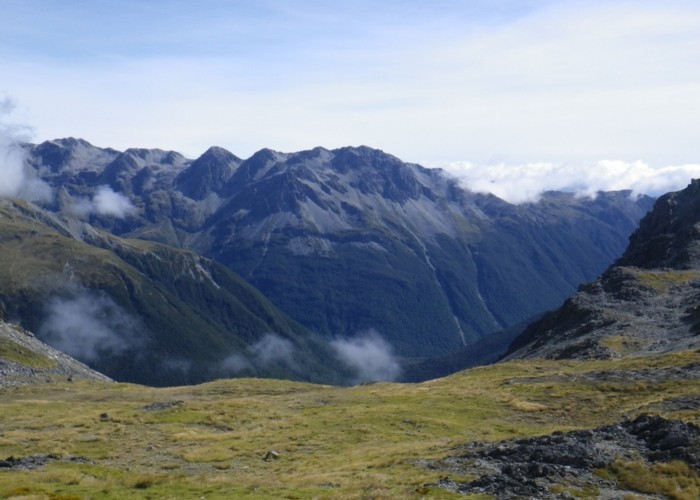
Despite the track, knees are aching by the time we navigate the last zigzag and reach the river. Six kilometres of sidling track through mature beech leads to the confluence with the West Sabine, crossing that deep slot gorge on a high bridge less than four meters long. We meet the first fellow trampers we’ve seen on this trip. Plodding tourists: clad, pristine, in the latest outdoor fashions. Heads bowed – a muttered greeting - exhausted from the climb. A sprightly lady makes easy work of the descent, startled by the shower of gravel I send here way. A chattering party of ten kiwi women enjoy crackers and cheese in a sunny clearing atop a brief climb. I try not to look like an unfed dog eyeing teatime.
West Sabine Hut is as I remember. Dark-shaded and tired in tall beech forest on the eastern bank. Twenty-plus bunks on platforms down one wall. A lone Frenchman listens to music on an i-pad; well-mannered enough to turn it off, chat, as I have some lunch. I vacillate over my onwards route. To head upriver to Blue Lake - over Moss Pass and down the D’Urville? It sounds like the more exciting route, but several tourist parties have already gone that way this morning – huts will be full. Or to stay here the night, in the cheerful company of crackers & cheese, take the easy stroll down the Sabine in the morning? But I crave solitude – can’t get excited by either prospect. So I split the difference, literally, and head for the tops of the range dividing D’Urville from Sabine, where the maps show Mt Misery Hut sitting in bleak isolation high above the bush.
Heading off down the Sabine Track, the quiet returns. The broad trail threads through tall beech on the flat valley floor. Nearby the river murmers as it flows sedately down its rocky bed. Raises its voice – a round of distant applause – as it discovers brief rapids down which to dance.
I choose a ‘good spur’ and climb towards pt1609. 1000m to go. Travel starts easy up a rocky fan, the outwash of a sharp gorged gut which descends from tarns on the tops. The gut starts to tighten, and I scramble out onto my spur. Leave the open boulder bed for dark forested slopes. We climb through open beech, trunks blacked with fungus, air sticky-sweet with honeydew. Gradient increases, and soon I’m using hands as well as feet, hauling myself up by those blackened trunks, following deer-trails as they climb. Then it all becomes less pleasant. Thick black beech trunks are replaced by spindly, mottled grey – tightly packed, impeding progress. Though the gradient has lessened, I’m straining with effort, clawing my way through the pole-beech jungle. 250 vertical meters of bush-bashing are required before I reach the open freedom of tussock basins above. What fun at the end of this long day?
An emerald tarn sits in the tussock basin. Only the forecast of rain prevents me from pitching my tent, collapsing exhausted on its banks into haven of canvas and down. Instead I head on, up lichen-mottled boulder scree – a final 200m to the ridgeline.
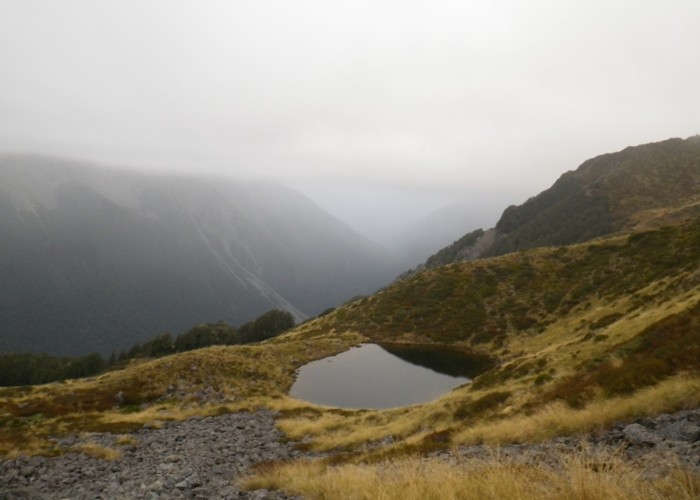
Cloud envelops the tops as I climb – views of the Sabine and peaks beyond fade into grey. The summit is reached with the last ounces of energy – digging into rations of tuna and muesli as body says ‘no more’. A narrow arched ridgeline tops the range, dropping steeply west – grey scree into mist. The eastern side is gentle, tussock basins holding small, dark-water tarns. A well trodden trail heads north down the ridge, we follow crossing low peaks in diminishing light. Mt Misery Hut lies 200m east of its namesake, invisible below in the misty near-night. We drop through saturated tussock into basins of mist, find the spot where the map shows the hut. Find nothing. A warratah appears, fades, as mist briefly lightens. We follow, drop north to a tarn, where Misery Hut stands grey against the mist. I enter, unpack - rain hisses on the roof – Misery lives up to its name. But still: so welcome, asylum from the night.
Paske Hut -> Rainbow / Paske Confluence
2hr. Animal track lead downriver from Paske Hut, crossing to the true left after 400m. An orange circle marks the start of a rough track through beech. Dropping back to the creek, tussock terraces on the TL lead downriver. Climb the clear benched track to terraces about 4km below the hut as the river gorges out. Follow terraces down to the confluence with the Rainbow on good cattle tracks.
Paske-Rainbow confluence -> Travers Saddle
3hr. Head up broad flats on the south side of the Rainbow until beech forest starts. Stick close to the creek, heading upriver through beech, river rocks and the base of scree fans on the TR. Remain on the TR as the valley swings north, sidling in, or above, beech until you reach the head basin.
2 routes appear possible.
1) climb the scree gut direct to the western side of the pass – though bluffs near the base mean you have to sidle into the bottom of the gut. I’ve not tried this, but from the top it looks possible but very steep. The last 50m will be the worst.
2) climb the last grassed rock face on the west to the base of bluffs. Sidle / climb north along the base of these bluffs, crossing one tricky ravine. The bluffs shrink back to the ridgeline, and following thoir base up and west leads to a large rocky basin 20m below the western ridgeline. It is possible, with extreme care, to sidle from this basin to the western side of Rainbow pass (20m to the NE of the basin). Ledges are narrow, but stable with good hand-holds, but the sidle is very exposed and a fall would be fatal.
From the Rainbow Pass, drop south into tarn-dotted flat tops of the Travers Saddle. The Travers-Sabine track is at the extreme northern extent of the flat saddle and marked by cairns and warratahs.
Travers Saddle -> West Sabine Hut
Follow warratahs down a well trodden track dropping west off the Travers Saddle. Sidling briefly north the track enters an avalanche-gut and zigzags down to the valley floor 500m below. A good cut marked rack runs through beech forest, descending to the Sabine confluence – the one river crossing is bridged. West Sabine Hut is 500m up the west branch from the forks. The bridge over the Sabine is now locate just upstream of the hut.
West Sabine Hut -> Mt Misery Hut
Cross the Sabine, and follow the Sabine Track downriver. Parties report climbing both the spurs east of pt1609 and pt1640. I chose 1609. Starting east up the boulder fan south of the spur, cut onto the spur as the side-valley tightens. Going is good – steep but open on faint deer trail - up to 1150m. Above 1150m the bush becomes stunted and tight with thick undergrowth. It is often necessary to drop north off the spur to find bush open enough to permit travel. The last 250 vertical meters to the bushedge are hard. From the bushedge cross to the small tarn 600m ESE of pt1609, and climb good stable rock-scree to the summit. A good ground trail follows the rounded (but narrow) ridgeline north to Mt Misery, crossing three low intermediate peaks. Mt Misery Hut is 200m east of the Mt Misery summit, nestled out of sight in a small basin beside a tarn. Warratahs lead north from the hut, so look out for those as you descend to avoid passing it.
Day 7 – Misery to Tiraumea
Mist cloaks the tops, promising to lift. Doesn’t. I wait, wait some more, leave.
Mist cloaks the tops. The only sound is my footsteps. I stop, stand silent. Hear just my breathing. I hold my breath, strain to listen. Faintly: the hiss of mist on my jacket. Mist cloaks the tops, brings silence. The only sound is me.
Poles lead south through the mist, swinging left off the ridgeline to drop steeply to beech forest below. A steep descent, trecherous – a sprinkling of beech leaves over clay. We descend. After time I become aware of the sound of the river: 500 vertical meters to go. We descend through beech, finally reaching the shore of Lake Rotoroa.
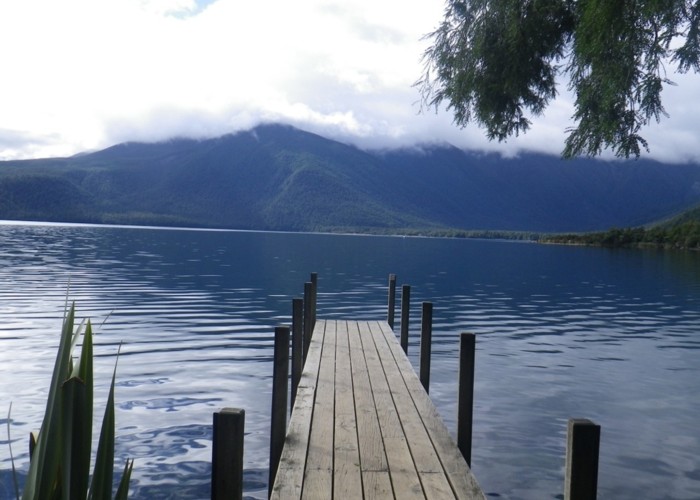
A good track runs west round the head of the lake, good expect for a couple of missing bridges. At the first a sign reads ‘dry undies -->’, points up a roughly cut track leading to a shallow crossing. A sign on the far side of the creek says ‘Pity about your boots!’. Back on the main track, we had on through tall beech before emerging onto grassy flats in the lower D’Urville. The poled track ends at a deep, swift crossing, but nosing 100m down river we find a good shallow ford. There are no markers on the far bank, so we cut west through a band of beech then stumble through a clearing of tall hummocked grass. The track on the far side, D’Urville Hut 500m north along it. Sandflies queue at the door as I remove dripping boots and socks, make ready my entrance. Lake Rotoroa is 10m away, calm water a mirror reflecting the pier.
The Tiraumea Track leaves the D’Urville 2km upriver of the hut, cutting west over a low saddle. A symphony of birdsong accompanies us as we start our climb: bellbirds and tuis providing the melody. As we climb, birdsong fades, replaced by the low hum of 1000s of wasps - 3 or 4 cruize every square meter of forest floor. The climb to the saddle is steep but easy, the Tiraumea River beyond a trickle between muddy pools. We descend gently through black fungus-clad beech, the river growing with each sighting. Clearings appear on the valley floor, thick with low scrub, flax and toetoe. The third is grassy, short-cropped and open. Tiraumea Hut stands just inside, 20m from the shelter of the beech. Two young hunters are resident, relaxing and feeding the sandflies. They hear one roar two days ago, nothing since, but optimistically plan the evening’s stalk.
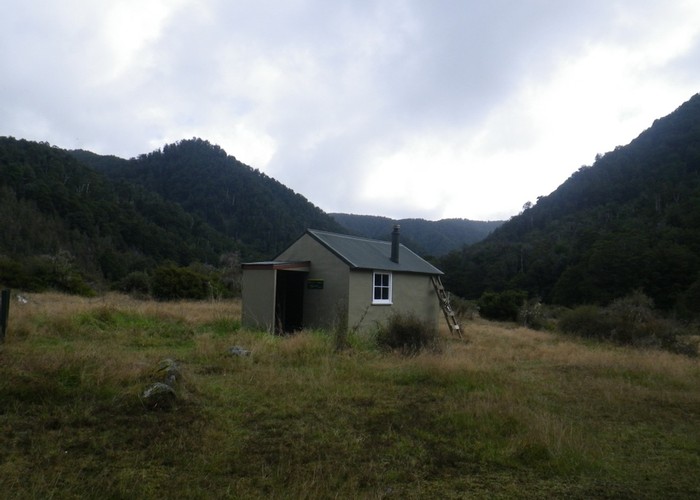
Godzone runners have been passing through all the previous day, and have left the dunny locked from the inside. Ritchie McCaw has apparently been competing. We contemplate finding him inside, dead on the throne. Agree that it's not worth risking the ruin of our trip to investigate But next morning, nature calls, and prizing the door open with a spade reveals no-one inside.
Misery Hut to D’Urville Hut
A poled route heads south from Misery Hut, gaining the ridgeline and following it NNE. At an unmarked point the route drops NW off the ridgeline to bush below – be alert for the ground trail ending – the face below has marker poles but there are none at the turn. A good but steep cut track descends through beech to the lakeshore, where it meets the Sabine-D’Urville track at a signposted junction.
From the Misery turnoff, follow the Sabine-D’Urville track west along the head of the lake in mature bush. One bridge is missing, but a bypass track is marked for 50m upstream to a good crossing. The track ends at the D’Urville. The river is not bridged, but good (thigh-deep) crossings were present 100m downriver when I visited after a night of steady rain. From the far bank continue west through a band of beech and hummocked clearing, to pick up the D’Urville track on the far side. D’Urville Hut is 500m north along the track, on the lake shore.
D’Urville Hut to Tiraumea Hut
From D’Urville Hut, head south for 2km along the D’Urville Track. A signposted track junction marks the turnoff to Tiraumea. This section of track can flood after heavy rain. A good cut track climbs to the Tiraumea Saddle then descends the Tiraumea River to the west through mature beech forest. Tiraumea Hut is located at the start of the third clearing and is on the track.
Day 8 – Tiraumea to Murchinson
I wander down the grassy flats from Tiraumea Hut in the first light of morning. Thin slices of cloud decorate the valleysides, forming, reforming in some scripted demonstration of dynamic equilibrium. The flats end all too soon, replaced by a winding V of a valley. The small stream, jumpable last time I saw it has magically transformed into a full-grown river, flowing over a broad bed of white rounded riverstones. As hinted at in the hut book, crossing are frequent, the track now a mere route down the stony riverbed.
A second major valley joins from the south, bringing river flats – moss-covered beech terraces alternating to left and right of the flow. Crossings become less common, a track forms on the terraces, good campsites frequent. Riverside clearings are flush with green grass – you can see why hunters like the place – it just screams ‘deer’. This morning, however, we see just one.
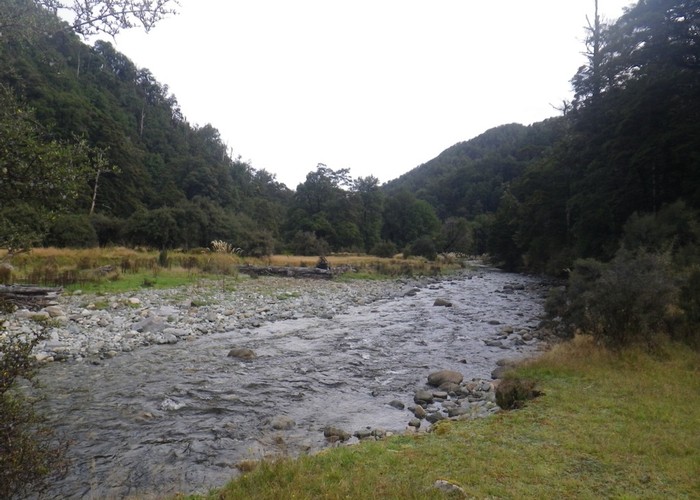
The valley opens further and beech forest recedes to the faces, flats of grass and toetoe cover the valley floor. The cry changes from ‘deer’ to ‘cattle’ and soon enough we spot their sign. A rickety fence spans the valley, a second – maintained – soon follows. Good pasture-grass paddocks replace the rough flats, the route poled and stiled down the riverside fenceline. Flats end in run-down sheepyards, tangled in blackberry. A farm track commences, a DOC carpark a few hundred meters beyond.
Sixteen kilometres of road-walking follows to reach the Buller. The asphalt Mangles Road follows the river as it leaves green dairy flats and squeezes into a tight beech-lad valley. The river is now full grown, running tannin stained below us. Sometimes rushing over brown-stained rocks, others lingering silent – dark pools between cliffs of black rock. Attempts at farming come and go to the south. Sheep graze faces of rough pasture, later replaced by low jungles of exotic regeneration – tangled battlefields fighting for the light. Throughout all the river flows to our right between banks of tall beech – fragrant with honeydew, and the faint smell of decay. Houses become more frequent, our road ends at the highway. The river surges on a few more meters, dropping eagerly down short water-smoothed rock falls to join the Buller below.
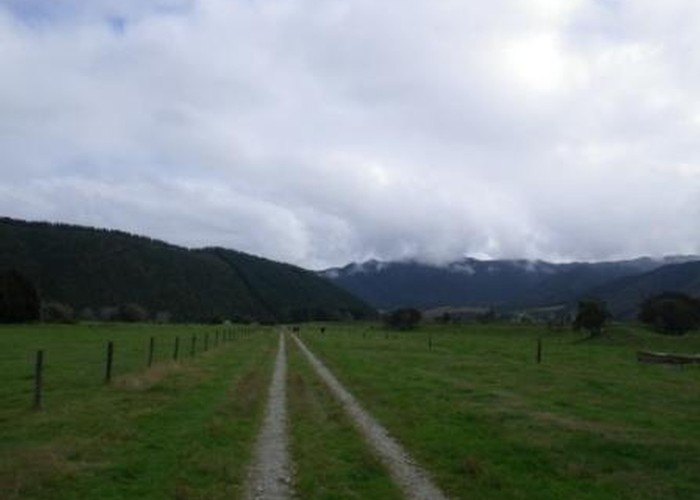
I make the detour west into Murchinson. A bed for the night at the Herbert Hotel, hot showers, a beer, and real food. Five kilometres more road walking a fair price for all that.
Tiraumea Hut to Tiraumea roadend
4hr. Follow river flats downriver from the hut. The valley soon tightens to a gorge and travel is in the riverbed with short sections of track until the Tirauma Forks. Crossings are frequent – generally knee deep in normal flows. This section is impassable after rain.
Below the main forks river flats are present and a track follows them downriver, crossing a further 8 times. The track is not marked, but is fairly obvious on the ground. A run-down fence is crossed, and soon after the route crosses to the northern bank. From here the track is poled, soon entering paddocks on terraces on the northern bank. The track ends at a DOC carpark 1km from the main road.
Tiraumea Roadend to Longford
4hr. From the carpark a 16km walk takes you north up Tutaki Road then west along the asphalt Mangles Valley Road to SH6 at Longford where River Lodge provides upmarket accommodation. Murchinson is a further 5km west along the highway and has a range of accommodation options, cafes and shops.

